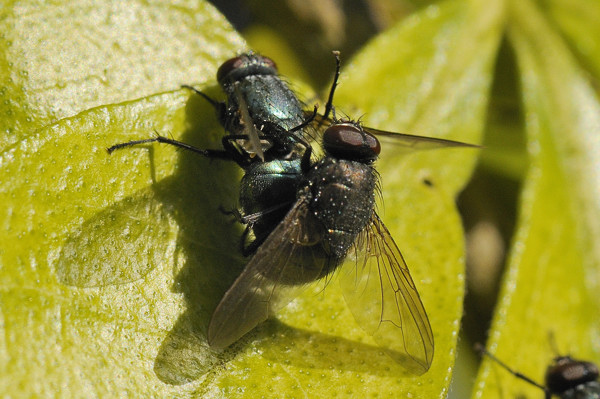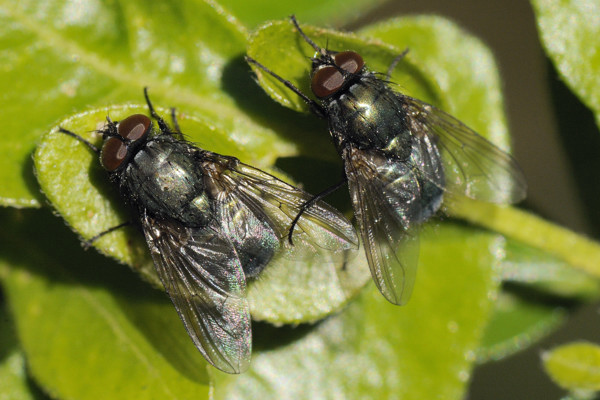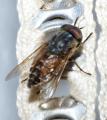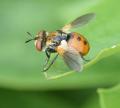Diptera.info :: Identification queries :: Diptera (adults)
Who is here? 1 guest(s)
|
Lucilia? early spring courtship/mating
|
|
| nick upton |
Posted on 17-03-2010 22:11
|
|
Member Location: Wiltshire, UK Posts: 815 Joined: 12.03.10 |
A lot of green/bronze metallic flies began courting and mating in the last week in my area as spring tried to arrive... Photos taken 13th/14th March 2009 in Wiltshire, southwest UK. Can anyone tell me if they are a Lucilia sp. possibly L.sericata? They vary in size and colour a fair bit and in the mating shot the male is more bronze coloured than the greener female, but in other shots the males are as green as the mated female. They seem smaller to me than some Lucilia I photographed later in the year last year. Is there a typically early emerging, smallish Lucilia species that I'm seeing, or is this something else altogether? NickU - generalist naturalist and photographer nick upton attached the following image:  [148.41Kb] |
|
|
|
| nick upton |
Posted on 17-03-2010 22:12
|
|
Member Location: Wiltshire, UK Posts: 815 Joined: 12.03.10 |
Another ? Lucilia shot with 2 males jostling for position i think. NickU nick upton attached the following image:  [147.61Kb] |
|
|
|
| tim worfolk |
Posted on 17-03-2010 22:45
|
|
Member Location: Devon, England Posts: 737 Joined: 05.05.09 |
not Lucilia, Eudasyphora cyanella Muscidae. shallow bend in medial vein. Tim |
|
|
|
| nick upton |
Posted on 18-03-2010 10:51
|
|
Member Location: Wiltshire, UK Posts: 815 Joined: 12.03.10 |
Many thanks Tim for a very helpful response and your link really spelled out how to identify this early season fly. I'd noticed that gentle curve in the medial vein and wondered if that was a significant character. In my garden, too, around 90% of the flies about are also males, with the few females getting a lot of attention..... and males are doing a lot of jumping on each other as well. I read elsewhere that this fly is a known pollinator of mistletoes, which blooms in Feb/March. see http://www.bioimages.org.uk/html/t83364.htm Maybe ties in with the early season emergence. Nick Edited by nick upton on 18-03-2010 10:57 |
|
|
|
| tim worfolk |
Posted on 18-03-2010 13:03
|
|
Member Location: Devon, England Posts: 737 Joined: 05.05.09 |
Glad to be of help. I've learned a lot in the last year or so (most importantly how little I know) from the real experts on this site. I've also picked up a few of the technical keys which, though designed for specimen/microscope use, can often be surprisingly useful with good photos. Now, if only someone could figure out a way to determine Lucilia spp. without needing to dissect them? Tim |
|
|
|
| nick upton |
Posted on 18-03-2010 16:41
|
|
Member Location: Wiltshire, UK Posts: 815 Joined: 12.03.10 |
I've not worked with keys and pinned insects since I was a student and even then, we knew there were some groups that would take forever to get even close....! Things really have moved on with digital photography, though, and a lot of insects do seem identifiable from good, sharp photos, especially when many angles have been taken, and I do know that I need to get clear shots of wing veins for diptera (and am learning more which bristly leg/ hairy eye etc I need to focus on for ID purposes for different families!) I do wonder if some keys might be adapted/ updated some day soon to be more usable based on photos not specimens... (maybe some already are..) as photo IDs are becoming useful for distribution recording schemes when photos get submitted to experts/ websites by photo enthusiasts without the need for collecting. Within weeks of starting to send out photos to experts and signing up to a few specialist sites, some of my shots of uncommon (or maybe actually just 'rarely recorded') species have already fed into recording schemes for Tephritidae, Conopidae and Ichneumonidae. With insect distributions changing all the time due to habitat loss/ climate change etc, I think that photo-based evidence could potentially become increasingly useful. I'm sure collecting will still be needed for many IDs where genitalia dissection etc is needed, for reference collections, research etc, but for basic ID/ distribution recording purposes, maybe photo friendly keys might begin to evolve. Maybe that's wishful thinking.... and friends of mine who are museum based entomologists will probably tell me so, but personally I'm not planning to start collecting more than photos. With photo-friendly keys available, my photographic work might help professional/scientific entomologists more. Just a thought! NickU Edited by nick upton on 18-03-2010 16:43 |
|
|
|
| tim worfolk |
Posted on 18-03-2010 18:50
|
|
Member Location: Devon, England Posts: 737 Joined: 05.05.09 |
Nick, I couldn't agree more. I don't collect and I have no intention of starting, but that's just a matter of time, space and my primary interest being photography. I'm glad that some people do and I'm happy to pass on any interesting specimens that come my way. As you say, one of the problems with photo-identification (apart from the technical difficulty) is getting the right shots - you get all the angles, pin sharp, but that critical bristle on the hind femur is always hidden. Of course you'll know where to look the next time you see it. Keys are, of course priceless, but I find that they're of most use if you know approximately which genus you're dealing with. The characters used to determine family, subfamily and genus are often the trickiest to see, although often they can be recognised 'provisionally' just on their general appearance. The experts of course, recognise their own groups because they know them so well, and I assume that they're not running them through a key each time. I wonder if the situation is in any way analogous to bird identification early in the 20th Century. Field ID of many species was considered impossible, you had to have a specimen to key out. Now, with all the usual caveats, I wonder if we can't push insect identification a little in that direction. Perhaps it's not just about checking the characters in the keys, maybe there are others not mentioned that could be used. I detect a certain disdain in some quarters from 'proper' entomologists (no-one on this site, I hasten to add) towards this approach. I think it's vital to not try to push things too far, clearly only 100% certain determinations should be submitted to recorders. But as you say, there's a lot of distributional data to be had from photographers, it may not be the same as specimens but it's better than no data. Like you, I've been thinking about this subject for a while and, rather than rambling on here, I think it's better consigned to my blog. BTW I don't know whether you've tackled any Tachinids yet but I strongly recommend them. There's a couple of really useful keys; the RES key by Belshaw is still in print (about £20 I think) and You might ask Chris Raper for a copy of his translation of Tschorsnig and Herting's Central European Key. There's always a lot of helpful expert advice here and Tachinids are really smart flies. Tim |
|
|
|
| nick upton |
Posted on 19-03-2010 10:42
|
|
Member Location: Wiltshire, UK Posts: 815 Joined: 12.03.10 |
Hi Tim, yes some good points. I guess the ease of bird ID may have improved as better optics became more available and now digiscoping is coming in for providing evidence of rare sightings. A parallel with the advent of high quality, affordable digital macro photography of insects maybe. And yes, some experts may be dismissive of amateur records and methods, but at the point where the latter clearly begin to achieve results and become useful to science (supplementing, not replacing the work of specialists) realistic experts should surely embrace this new source of information (as clearly happens a lot on this site!). As for the need for beginners' / non experts' guides to knowing what family/ genus one is looking at, that would really help. I rely on distant memories of sketchy student entomological courses and some very basic books, and go a lot on the "jizz" as i do for birds, but there are many families of small flies that stump me completely still, as I never met them before and the basic books have maybe one poor drawing of a not very representative species! An online guide / key to identifying insects to family / genus level and advice on what keys to go to for further detail would really help a lot of non specialists. Maybe there is one, but I've not come across it yet. As for tachinids, I know Tachina fera well and it makes for great shots, and I did recently get a really small one identified - to Ramonda spathulata - probably... - through this site and will be looking out for more tachinids this year. Chris tells me to look out for the jazzy green Gymnocheta viridis when the sun next shines. Thanks for the tip on affordable, useful keys. Nick |
|
|
|
| tim worfolk |
Posted on 19-03-2010 11:49
|
|
Member Location: Devon, England Posts: 737 Joined: 05.05.09 |
Nick, I take your point about better optics but actually I was thinking more of the field guide revolution started by Peterson. As for general/family keys, have you looked at these two: Dipterist Forum - Key to Families (Ball) http://www.dipter...ptera.html You may need to become a member but highly recommended. FSC AIDGAP key - A Key To The Families of British Diptera (Unwin) http://www.field-..._143_A.pdf I particularly like Stuart Ball's key, very nicely illustrated and as clear and simple as these things are ever going to be. best of luck Tim |
|
|
|
| nick upton |
Posted on 19-03-2010 19:30
|
|
Member Location: Wiltshire, UK Posts: 815 Joined: 12.03.10 |
Tim, OK, yes, the advent of decent field guides with notes on what to look for in birds "in the bush" rather than in the hand must have made a huge difference, and i guess that's what I need for insects really! Many thanks for the tips on what basic keys are out there. Will check them out. Nick |
|
|
|
| Jump to Forum: |













 but don't see the image in the post.
but don't see the image in the post.
